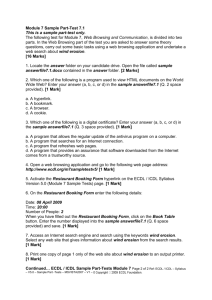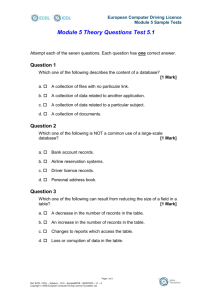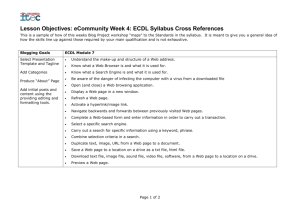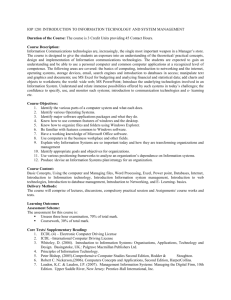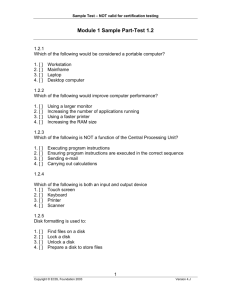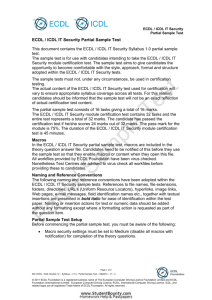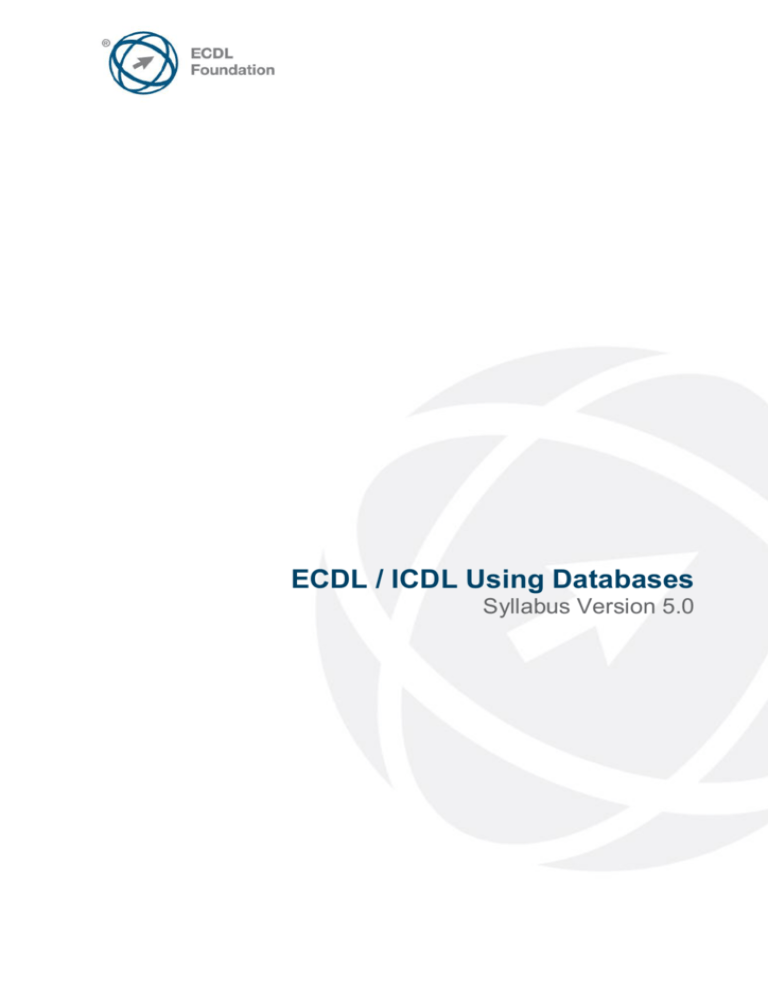
ECDL / ICDL Using Databases
Syllabus Version 5.0
Purpose
This document details the syllabus for ECDL / ICDL Using Databases. The syllabus
describes, through learning outcomes, the knowledge and skills that a candidate for
ECDL / ICDL Using Databases should possess. The syllabus also provides the basis
for the theory and practice-based test in this module.
Copyright © 2007 ECDL Foundation
All rights reserved. No part of this publication may be reproduced in any form except
as permitted by ECDL Foundation. Enquiries for permission to reproduce material
should be directed to ECDL Foundation.
Disclaimer
Although every care has been taken by ECDL Foundation in the preparation of this
publication, no warranty is given by ECDL Foundation, as publisher, as to the
completeness of the information contained within it and neither shall ECDL
Foundation be responsible or liable for any errors, omissions, inaccuracies, loss or
damage whatsoever arising by virtue of such information or any instructions or advice
contained within this publication. Changes may be made by ECDL Foundation at its
own discretion and at any time without notice.
ECDL Foundation is a registered business name of The European Computer Driving Licence Foundation Limited and ECDL Foundation
(International) Limited. European Computer Driving Licence, ECDL, International Computer Driving Licence, ICDL, and related logos are all
registered Trade Marks of ECDL Foundation. All rights reserved.
Copyright © 2007 ECDL Foundation
Ref: ECDL / ICDL Using Databases – Syllabus – V5.0
Page 2 of 7
ECDL / ICDL Using Databases
This module sets out essential concepts and skills relating to understanding the concept of a
database and demonstrating competence in using a database.
Module Goals
Successful candidates will be able to:
Understand what a database is and how it is organized and operated.
Create a simple database and view the database content in various modes.
Create a table, define and modify fields and their properties; enter and edit data in a
table.
Sort and filter a table or form; create, modify and run queries to retrieve specific
information from a database.
Understand what a form is and create a form to enter, modify and delete records and
data in records.
Create routine reports and prepare outputs ready for distribution.
CATEGORY
1 Understanding
Databases
SKILL SET
1.1 Key Concepts
1.2 Database Organization
Copyright © 2007 ECDL Foundation
REF.
TASK ITEM
1.1.1
Understand what a database is.
1.1.2
Understand the difference
between data and information.
1.1.3
Understand how a database is
organized in terms of tables,
records and fields.
1.1.4
Know some of the common uses
of large-scale databases like:
airline booking systems,
government records, bank
account records, hospital patient
details.
1.2.1
Understand that each table in a
database should contain data
related to a single subject type.
1.2.2
Understand that each field in a
table should contain only one
element of data.
1.2.3
Understand that field content is
associated with an appropriate
data type like: text, number,
date/time, yes/no.
Ref: ECDL / ICDL Using Databases – Syllabus – V5.0
Page 3 of 7
CATEGORY
SKILL SET
1.3 Relationships
1.4 Operation
2 Using the
Application
Copyright © 2007 ECDL Foundation
2.1 Working with Databases
REF.
TASK ITEM
1.2.4
Understand that fields have
associated field properties like:
field size, format, default value.
1.2.5
Understand what a primary key
is.
1.2.6
Understand what an index is.
Understand how it allows for
faster data access.
1.3.1
Understand that the main
purpose of relating tables in a
database is to minimize
duplication of data.
1.3.2
Understand that a relationship is
built by matching a unique field in
one table with a field in another
table.
1.3.3
Understand the importance of
maintaining the integrity of
relationships between tables.
1.4.1
Know that professional
databases are designed and
created by database specialists.
1.4.2
Know that data entry, data
maintenance and information
retrieval are carried out by users.
1.4.3
Know that a database
administrator provides access to
specific data for appropriate
users.
1.4.4
Know that the database
administrator is responsible for
recovery of a database after a
crash or major errors.
2.1.1
Open, close a database
application.
2.1.2
Open, close a database.
2.1.3
Create a new database and save
to a location on a drive.
2.1.4
Display, hide built-in toolbars.
Restore, minimize the ribbon.
2.1.5
Use available Help functions.
Ref: ECDL / ICDL Using Databases – Syllabus – V5.0
Page 4 of 7
CATEGORY
SKILL SET
2.2 Common Tasks
3 Tables
3.1 Records
3.2 Design
4 Retrieving
Information
Copyright © 2007 ECDL Foundation
4.1 Main Operations
REF.
TASK ITEM
2.2.1
Open, save and close a table,
query, form, report.
2.2.2
Switch between view modes in a
table, query, form, report.
2.2.3
Delete a table, query, form,
report.
2.2.4
Navigate between records in a
table, query, form.
2.2.5
Sort records in a table, form,
query output in ascending,
descending numeric, alphabetic
order.
3.1.1
Add, delete records in a table.
3.1.2
Add, modify, delete data in a
record.
3.2.1
Create and name a table and
specify fields with their data
types like: text, number,
date/time, yes/no.
3.2.2
Apply field property settings: field
size, number format, date/time
format, default value.
3.2.3
Create a validation rule for
number, date/time, currency.
3.2.4
Understand consequences of
changing data types, field
properties in a table.
3.2.5
Set a field as a primary key.
3.2.6
Index a field (with, without
duplicates allowed).
3.2.7
Add a field to an existing table.
3.2.8
Change width of columns in a
table.
4.1.1
Use the search command for a
specific word, number, date in a
field.
4.1.2
Apply a filter to a table, form.
Ref: ECDL / ICDL Using Databases – Syllabus – V5.0
Page 5 of 7
CATEGORY
SKILL SET
4.2 Queries
5 Objects
6 Outputs
Copyright © 2007 ECDL Foundation
5.1 Forms
6.1 Reports, Data Export
REF.
TASK ITEM
4.1.3
Remove the application of a filter
from a table, form.
4.2.1
Understand that a query is used
to extract and analyse data.
4.2.2
Create a named single table
query using specific search
criteria.
4.2.3
Create a named two-table query
using specific search criteria.
4.2.4
Add criteria to a query using one
or more of the following
operators: = (Equal), <> (Not
equal to), < (Less than), <= (Less
than or equal to), > (Greater
than), >= (Greater than or equal
to).
4.2.5
Add criteria to a query using one
or more of the following logical
operators: AND, OR, NOT.
4.2.6
Use a wildcard in a query, * or %,
? or __.
4.2.7
Edit a query: add, modify,
remove criteria.
4.2.8
Edit a query: add, remove, move,
hide, unhide fields.
4.2.9
Run a query.
5.1.1
Understand that a form is used to
display and maintain records.
5.1.2
Create and name a form.
5.1.3
Use a form to insert new records.
5.1.4
Use a form to delete records.
5.1.5
Use a form to add, modify, delete
data in a record.
5.1.6
Add, modify text in headers,
footers in a form.
6.1.1
Understand that a report is used
to print selected information from
a table or query.
Ref: ECDL / ICDL Using Databases – Syllabus – V5.0
Page 6 of 7
CATEGORY
SKILL SET
6.2 Printing
Copyright © 2007 ECDL Foundation
REF.
TASK ITEM
6.1.2
Create and name a report based
on a table, query.
6.1.3
Change arrangement of data
fields and headings within a
report layout.
6.1.4
Present specific fields in a
grouped report by sum,
minimum, maximum, average,
count, at appropriate break
points.
6.1.5
Add, modify text in headers,
footers in a report.
6.1.6
Export a table, query output in
spreadsheet, text (.txt, .csv),
XML format to a location on a
drive.
6.2.1
Change the orientation (portrait,
landscape) of a table, form,
query output, report. Change
paper size.
6.2.2
Print a page, selected record(s),
complete table.
6.2.3
Print all records using form
layout, specific pages using form
layout.
6.2.4
Print the result of a query.
6.2.5
Print specific page(s) in a report,
print complete report.
Ref: ECDL / ICDL Using Databases – Syllabus – V5.0
Page 7 of 7

